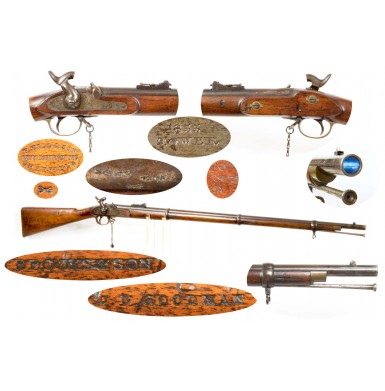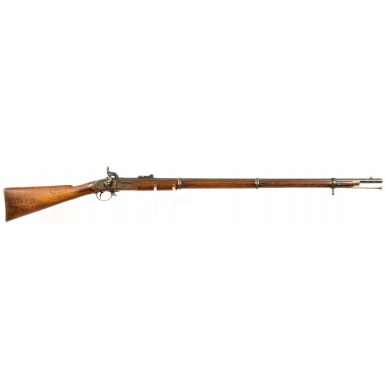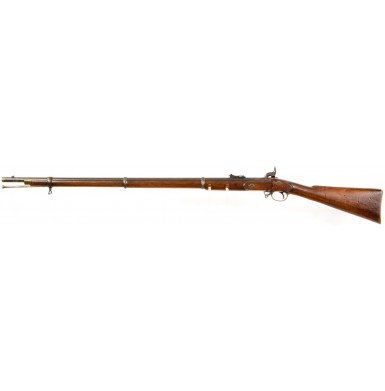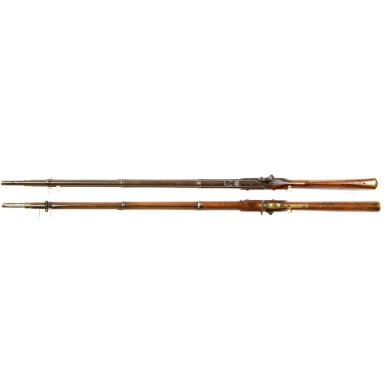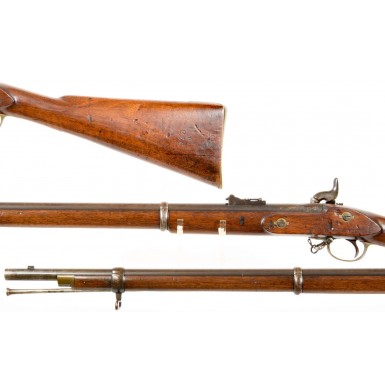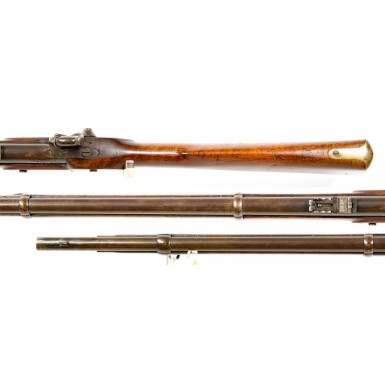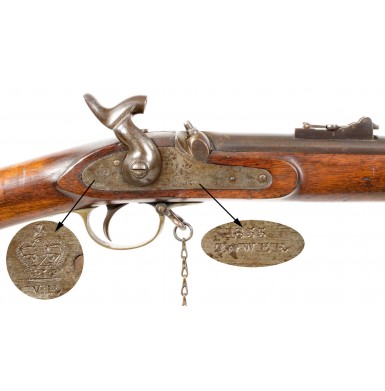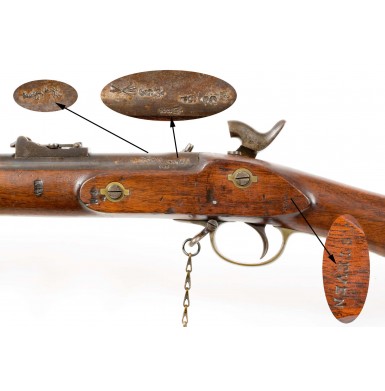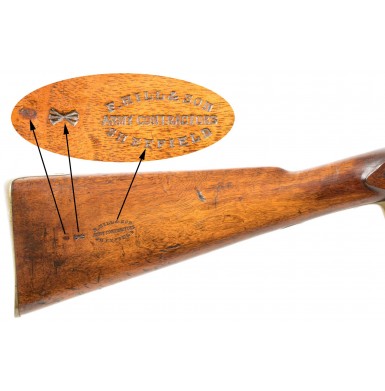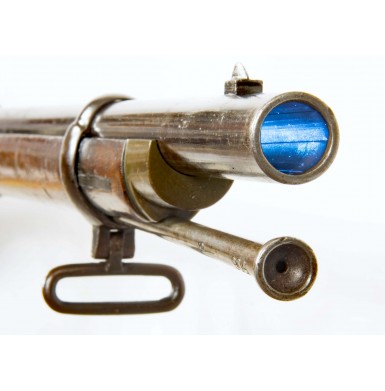Crimean War Dated Type II P1853 Enfield Rifle Musket
- Product Code: FLA-3566-SOLD
- Availability: Out Of Stock
-
$1.00
This is a FINE example of a Crimean War period British Military Pattern 1853 Type II Rifle Musket. The “Type II” guns are instantly recognizable because they were the only variant of Enfield rifle muskets to use solid barrel bands, retained by band springs, instead of the more often encountered screw-tensioned clamping barrel bands. The upper barrel band is particularly noticeable because it is so much wider than on any other series of Enfield muskets.
The “Type II” Enfield rifle muskets were produced from 1855-1858 and incorporated a number of improvements that were suggested after the Type I Enfields saw significant service during the early days of the Crimean War (October 1853- February 1856). One of these improvements was a new, sturdier hammer that eliminated the curl on the spur that typified the hammers of Type I Pattern 1853s as well as the earlier Pattern 1839, 1842 and 1851 muskets. The guns also adopted the solid barrel bands that have already been discussed. The “Type II” Pattern 1853 rifle muskets dispensed with the convex sides to the rear sight, replacing them with flat sides. The other change that took place with later production “Type IIs” was the change from a button-head rammer to a slotted, jag-head rammer and a change in the location of the swell that retained the rammer in the rammer channel.
The Type II Pattern 1853 Enfield Rifle Muskets were produced by the usual assortment of London and Birmingham contractors, as well as at the Royal Small Arms Factory (RSAF) at Enfield Lock. A number of the earliest production Pattern 1853 Type II Enfield Rifle Muskets, typically the 1855 dated guns, ended up seeing service in the Crimea. As a result, these guns tend to be found in rather rough condition and 1855 dated Type IIs in fine condition are rarely encountered. The balance of the Type II rifle muskets saw front line service with the British Army until they were superseded by the Type III Enfield Rifle Musket. The Type III was the standard “Civil War” period Enfield and went into service around 1858, at which time the majority of the earlier Type II guns were put into secondary service with British militia companies (aka “Rifle Volunteers”) or held in storage for emergency use.
While the “Type II” Enfield has long been considered a pattern that was not imported during the Civil War, a handful of British Military marked, pre-Civil War dated Enfields are known with Confederate import marks, indicating that at least some of these 2ndclass British military guns were imported during the Civil War – likely in the opening days when the British gunmakers could not begin to handle the influx of orders from both combatants.
The British Military Type II Pattern 1853 Rifle Musket offered here is in about FINE condition. The lock is clearly marked with a Crown / VR behind the hammer and 1855 / TOWER forward of the hammer. The toe of the stock is marked with the names the JD GOODMANand B BROOKS & SON and the obverse buttstock is marked with a three-line oval cartouche that reads F HILL & SON / ARMY CONTRACTORS / SHEFFIELD. To the rear of this marking are a pair of “Opposed Broad Arrows”which is the “sold out of service mark”, as well as a weak 2 indicating “2ndClass”. The names along the toe of the stock represent the master contractor who made the gun and likely the stock maker. While later production Enfields usually had stock maker mark in the barrel or ramrod channels, earlier production guns sometimes had the mark along the stock toe. J.D. Goodman is likely John Goodman, who was a London gunmaker who became a journeyman in 1841 and was certainly a master gun maker by the mid-1850s. The Brooks mark is likely the mark of a family of London gunmakers, Benjamin Brooks, which went back several generations to the first quarter of the 18thcentury. The Hill & Son contractor mark is likely the retailer who resold the gun after it was released from British military service, acting as a military surplus dealer. Hill does not appear to have been a gunmaker, as the firm is not listed in any of my numerous references on the English gun trade. The reverse buttstock is marked with the rack number R / 236, which was probably applied when the gun was doing service as a 2ndclass reserve gun after the adoption of the Type III P1853. The ramrod is also numbered, in this case 506, which is engraved near the cupped tulip-style head. The stock flat, opposite the lock, is marked W STEVEN, the mark of the “setter up” who did the final assembly and fitting of the gun’s components. The interior of the lock is marked WS over the mainspring and JD near the mainspring boss stud. Usually the name or initials over the mainspring would be the mark of the contractor who made the gun and mark closer to the stud is the lock maker. However, as neither of these marks coincide with the contractor names in the toe of the stock, it is difficult to know which makers these initials refer to. The top edge of the lock is marked with the assembly mating mark XIII. This same assembly mark is found on the necks of both the lock screws and the breech plug tang screw. The marks are also found on the rear interior edges of the barrel bands and on the bottom of the barrel. The bottom of the barrel is additionally marked with the barrel maker’s name; Henry Clive. The barrel is also marked with several assembly and inspection marks. The breech of the barrel is marked with the usual British military inspection and proof marks, as well as with an opposed set of Broad Arrows, indicating the gun was released from government stores at the end of its service life. Numerous additional inspector marks are found throughout the gun, including a number of small Crown / G / inspector number marks, most being G/3 with a couple of G/1 marks as well.
The gun is very attractive and retains about 25%+ of its original deep blue on the exposed surfaces of the barrel, with substantial thinning and fading. The areas where the barrel has lost finish has a mostly plum brown patina, with some additional surface oxidation and discoloration and a few areas where the patina shows wear and a medium pewter patina. The bottom of the barrel retains about 70%+ of its original blued finish, where it has been protected by the stock. The barrel is mostly smooth, with some scattered pinpricking, some light pitting around the breech and scattered flecks of surface oxidation and some minor patches of additional oxidation here and there. The barrel bands have a matching plum patina as well, with flecks of original blue here and there. The lock shows some traces and hints of case coloring, which has faded and mellowed, developing a mottled grayish patina. The hammer has a similar patina. The action of the gun is mechanically functional, and the lock operates crisply and correctly on all positions. The bore of the gun is in about FINE condition and retains crisp rifling. The bore is mostly bright with only some scattered light oxidation and some minor pinpricking here and there. The rear sight is original and complete and remains in fine, completely functional condition. The original combination front sight and bayonet lug is present as well. The gun retains both of its original sling swivels as well and an original, period cone (nipple) protector is present at well. The “snap cap” is complete with the exception of some loss to the leather padding. The original rammer is also located in the rammer channel under the barrel. This gun has the earlier pattern Type I, swelled-shank, tulip-head ramrod, which remained in use during the first year or so of Type II P1853 production, eventually being replaced with the jag-head Type II rod. The rod is full-length and complete with threads on the end. The rammer is not only numbered, but is marked with a G/3 inspection mark and the maker initials JG. The brass furniture has a lovely, uncleaned dark mustard patina that is truly attractive. The stock is in about FINE condition as well, with very sharp edges and some traces of “feathery” wood texture. Even the rammer channel is relatively sharp and shows little wear, which is not typical of Type II Enfields with the swelled rammer. The stock is full-length and free of any breaks, cracks or repairs and remains completely solid throughout. The stock shows the usual assortment of scattered bumps, dings and mars, as well as a few storage scuffs, all of which are typical of a military service rifle. However, the gun shows no abuse.
Overall this is a very attractive, FINE condition, Crimean War era British Military Pattern 1853 Type II Enfield Rifle Musket. These Crimean War dated Pattern 1853s are fairly scarce on the collector market, particularly in higher grades of condition. For a collector of British military percussion service rifles, a Type II P1853 is significantly harder to find than a Type III or Type IV, both of which were produced in much greater numbers than the Type IIs. For a collector of Crimean War militaria, a P1853 in this condition will certainly be a wonderful addition to your collection and is a gun you will surely be glad to add to your collection.
SOLD
Tags: Crimean, War, Dated, Type, II, P1853, Enfield, Rifle, Musket

